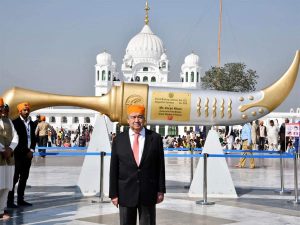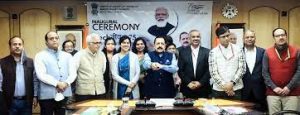Today Current Affairs: 17th November 2021 for UPSC IAS exams, State PSC exams, SSC CGL, State SSC, RRB, Railways, Banking Exam & IBPS, etc
Table of Contents
Kartarpur Corridor:

The government is considering reopening the Kartarpur Sahib Gurudwara corridor to Pakistan this week to allow Sikh pilgrims to cross over, more than 20 months after it was shut down due to the Coronavirus pandemic.
- The plan is to open on November 19, the birth anniversary of the Sikh founder Guru Nanak, known as Gurpurab or “Prakash Parv”.
The Kartarpur corridor agreement:
- The Kartarpur corridor agreement allows pilgrims to travel visa free through the corridor.
- Indian pilgrims of all faiths and persons of Indian origin can use the corridor.
- Pilgrims need to carry only a valid passport;
- Persons of Indian Origin need to carry OCI card along with the passport of their country.
- The Corridor is open from dawn to dusk. Pilgrims travelling in the morning will have to return on the same day.
- The corridor – often dubbed as the “Road to Peace” – will connect Gurdwara Darbar Sahib in Pakistan’s Kartarpur with Dera Baba Nanak shrine in India’s Gurdaspur district.
Special Courts:

The Supreme Court has decided to examine questions regarding the legal jurisdiction of the special courts set up to exclusively prosecute Members of Parliament and State Legislative Assemblies for various offences.
- There are more than 4000 cases pending against legislators across the country. Of this, the number of cases against sitting Members of Parliament and members of State legislatures was 2,556.
- The cases against the legislators include that of corruption, money laundering, damage to public property, defamation and cheating.
- A large number of cases were for violation of Section 188 IPC for wilful disobedience and obstruction of orders promulgated by public servants.
- A large number of cases were pending at the appearance stage and even non-bailable warrants (NBWs) issued by courts have not been executed.
- Besides, in Bihar, 89% Assembly constituencies have three or more candidates who have declared criminal cases against themselves in their affidavits for the ongoing elections.
- A three-judge committee of the Madras High Court, in November 2020, questioned the constitutional validity of setting up special courts to exclusively try MPs and MLAs for various crimes.
Rashtriya Gokul Mission:

A review meeting on the performance of the Rashtriya Gokul Mission was held recently.
- ‘Rashtriya Gokul Mission’ was launched in 2014 to conserve and develop indigenous bovine breeds, under the National Programme for Bovine Breeding and Dairy Development (NPBBD).
Key objectives of the mission:
- Development and conservation of indigenous breeds.
- Undertake breed improvement programme for indigenous cattle breeds so as to improve the genetic makeup and increase the stock.
- Enhance milk production and productivity.
- Upgrade nondescript cattle using elite indigenous breeds like Gir, Sahiwal, Rathi, Deoni, Tharparkar, Red Sindhi.
- Distribute disease free high genetic merit bulls for natural service
It is being implemented through the “State Implementing Agency’ Livestock Development Boards, i.e., SIA’s (LDB’s).
- State Gauseva Ayogs are mandated to sponsor proposals to the SIA’s (LDB’s) and monitor implementation of the sponsored proposal.
- The “Participating Agencies” like CFSPTI, CCBFs, ICAR, Universities, Colleges, NGO’s, Cooperative Societies and Gaushalas with best germplasm.
Gokul Grams:
- The Rashtriya Gokul Mission envisages the establishment of integrated cattle development centers, ‘Gokul Grams’ to develop indigenous breeds including up to 40% nondescript breeds.
- Gokul Grams will be established in:
- The native breeding tracts and
- Near metropolitan cities for housing the urban cattle.
- Objectives:
- Promote indigenous cattle rearing and conservation in a scientific manner.
- Propagate high genetic merit bulls of indigenous breeds.
- Optimize modern Farm Management practices and promote Common Resource Management.
- Utilize animal waste in an economical way i.e. Cow Dung, Cow Urine.
- They will be self-sustaining and will generate economic resources from sale of A2 milk organic manure, vermi-composting, urine distillates, and production of electricity fraom bio gas for in house consumption and sale of animal products.
- They will also function as state of the art in situ training centre for Farmers, Breeders and MAITRI’s.
- Gokul Grams act as Centres for development of Indigenous Breeds and a dependable source for supply of high genetic breeding stock to the farmers in the breeding tract.
- The Gokul Gram will maintain milch and unproductive animals in the ratio of 60:40 and will have the capacity to maintain about 1000 animals.
- Nutritional requirements of the animals will be provided in the Gokul Gram through in house fodder production.
Green Bonds:

Corporate green-bond issuance has reached new highs as U.S. companies including chip maker Micron Technology Inc., retailer Walmart Inc. and data-center company Equinix Inc. add the bonds as part of larger traditional bond offerings.
- The increasing issuance of green bonds, which finance environmentally friendly projects, comes as companies face pressure from investors, regulators and employees to show the steps they are taking to improve the environment. One way they do that is by issuing debt tied to sustainability targets.
- A green bond is a type of fixed-income instrument that is specifically earmarked to raise money for climate and environmental projects.
- These bonds are typically asset-linked and backed by the issuing entity’s balance sheet, so they usually carry the same credit rating as their issuers’ other debt obligations.
- Green bonds may come with tax incentives to enhance their attractiveness to investors.
- The World Bank is a major issuer of green bonds. It has issued 164 such bonds since 2008, worth a combined $14.4 billion.
- In 2020, the total issuance of green bonds was worth almost $270 billion, according to the Climate Bond Initiative.
- Green bonds work just like any other corporate or government bond.
- Borrowers issue these securities in order to secure financing for projects that will have a positive environmental impact, such as ecosystem restoration or reducing pollution.
- Investors who purchase these bonds can expect to make as the bond matures.
- In addition, there are often tax benefits for investing in green bonds.
Unified Payments Interface (UPI):

The Unified Payments Interface (UPI) payments system has cut across the Indian socio-economic digital divide amazingly fast.
- Even though UPI is indeed a groundbreaking innovation in the digital payments landscape, reliability and security are still considered to be at stake, keeping many individuals and businesses apprehensive about the payment system.
Unified Payments Interface (UPI):
- It is an advanced version of Immediate Payment Service (IMPS)- round–the-clock funds transfer service to make cashless payments faster, easier and smoother.
- UPI is a system that powers multiple bank accounts into a single mobile application (of any participating bank), merging several banking features, seamless fund routing & merchant payments into one hood.
- UPI is currently the biggest among the National Payments Corporation of India (NPCI) operated systems including National Automated Clearing House (NACH), Immediate Payment Service (IMPS), Aadhaar enabled Payment System (AePS), Bharat Bill Payment System (BBPS), RuPay etc.
- The top UPI apps today include PhonePe, Paytm, Google Pay, Amazon Pay and BHIM, the latter being the Government offering.
- As part of an agreement, India’s UPI will be linked to Singapore’s PayNow.
- NPCI launched UPI with 21 member banks in 2016.
Devasahayam Pillai:

Devasahayam Pillai, an 18th-century Hindu convert to Christianity, would be the first Indian layman (a non-ordained member of the Church) to be made a saint.
- Pope Francis will canonize Blessed Devasahayam Pillai, together with six other Blesseds, during a Canonization Mass in St Peter’s Basilica in Vatican on 15th May, 2022.
- Vatican City is the seat of the Roman Catholic Church.
- He was born on 23rd April 1712 in the village of Nattalam in Tamil Nadu’s Kanyakumari District.
- Known as Nilakanda Pillai before embracing Christianity, he grew up in an upper caste family of temple priests.
- He went on to serve in the court of Travancore’s Maharaja Marthanda Varma. It was here that he met a Dutch naval commander, who taught him about the Catholic faith.
- He became a Catholic in 1745. Pillai took the Christian name Lazarus, but later came to be known as Devasahayam (God’s help).
- He then faced the wrath of the Travancore state, which was against his conversion.
- On 14th January, 1752, just seven years after he became a Catholic, Devasahayam was shot dead in the Aralvaimozhy forest.
- Since then, he has widely been considered a martyr by the Catholic community in South India.
- His body is at Saint Francis Xavier Cathedral in the Diocese of Kottar (Tamil Nadu).
- The Church is of the view that his preaching of equality of all people despite caste differences eventually led to his martyrdom.
- He was first approved for sainthood in February 2020 for “enduring increasing hardships” after he decided to embrace Christianity.
SITMEX-2021:

The third edition of the trilateral naval exercise Singapore-India-Thailand Maritime Exercise (SITMEX) has been conducted in the Andaman Sea of the Indian Ocean.
- It is conducted annually, and was announced by India at Shangri-La Dialogue in June 2018.
- The International Institute for Strategic Studies (IISS) Shangri-La Dialogue is Asia’s premier defence summit. It was launched in 2002.
- The first edition of SITMEX was hosted by the Indian Navy, and was conducted off Port Blair in September 2019.
- Singapore hosted the second edition of the exercise in November 2020. The 2021 edition of the exercise is being hosted byThailand.
- It includes a number of tactical training drills such as naval manoeuvres and surface warfare exercises.
- It aims to strengthen mutual confidence and develop common understanding and procedures towards enhancing the overall maritime security in the Indo-Pacific region.
- The exercise is in line with India’s SAGAR (Security and Growth for All in the Region) vision.
Tech NEEV @75:

Union Minister Dr. Jitendra Singh today inaugurated “Tech NEEV/ नींव @75” as part of Azadi ka Amrit Mahotsav and interacted with successful start-ups including those from the tribal communities on the occasion of Janjatiya Gaurav Diwas.
- The Government of India will be setting up 30 Science Technology and Innovation (STI) Hubs in different parts of the country for Scheduled Tribes (STs) by end of 2022 to promote scientific talent among tribal communities and for their overall socio-economic development.
- Out of 75 proposed STI Hubs for SCs/STs, 20 have already been established by Department of Science and Technology which will directly benefit 20,000 people through various interventions spreading across farm, non-farm and other allied livelihood sectors.
- “Tech NEEV/ नीव @ 75” is a year-long celebration highlighting the impact of Science Technology Innovation (STI) in empowering community for creating equitable inclusive economic growth.
- The 75 hour programme includes experience sharing of beneficiaries, community change leaders, societal changemakers conclave and round table discussions by various stakeholders apart from compilation of 75 impactful stories on India’s progress towards Aatma Nirbhar Bharat.
- Referring to the Prime Minister’s Slogan of New India “Jai Jawan, Jai Kisan, Jai Vigyan, Jai Anusandhan”, Dr Jitendra Singh said, it reverberates the importance of Science and Technology in transforming the life of the poorest of the poor and developing affordable technologies.
41st Scientific Expedition To Antarctica:

India has successfully launched the 41st Scientific Expedition to Antarctica with the arrival of the first batch of its contingent at the southern white continent.
- The 41st expedition has two major programs.
- The first program encompasses geological exploration of the Amery ice shelf at Bharati station. This will help explore the link between India and Antarctica in the past.
- The second program involves reconnaissance surveys and preparatory work for drilling of 500 meters of ice core near Maitri.
- It will help in improving the understanding of Antarctic climate, westerly winds, sea-ice and greenhouse gases from a single climate archive for past 10,000 years.
- The Indian Antarctic program, which began in 1981, has completed 40 scientific expeditions, and built three permanent research base stations in Antarctica, named DakshinGangotri (1983), Maitri (1988) and Bharati (2012).
- As of today, Maitri and Bharati are fully operational.
- The National Centre for Polar and Ocean Research (NCPOR), Goa—an autonomous institute under the Ministry of Earth Sciences—manages the entire Indian Antarctic program.
New Protocol For Post-Mortem Procedure:

Union Health Ministry of India notifies new protocol for post-mortem procedure.
- The Government of India announced that it has made changes in post-mortem protocols to allow for the procedure to be conducted after sunset effective from November 15, 2021.
- The move, union health ministry said, is order to promote ease of living by reducing burden imposed due to compliance to government processes.
- Apart from friends and relatives of the deceased, this new procedure also promotes organ donation and transplant as organs can be harvested in the stipulated time window after the procedure, the union health ministry said in a statement.
- In view of the rapid advancement and improvement in technology, especially availability of required lighting and infrastructure required for post-mortem, performing night time post-mortem in hospitals is now feasible.
- The protocol stipulates that post-mortem for organ donation be taken up on priority and be conducted even after sunset at the hospitals which have the infrastructure for conducting such post-mortem on a regular basis.
- The government further said that fitness and adequacy of infrastructure etc., shall be assessed by the hospital-in-charge to ensure that there is no dilution of evidentiary value.
- It is also to be ensured by the facility that video recording of post-mortem shall be done for all post-mortem conducted in the night, to rule out any suspicion and preserved for future reference for Legal purposes.
- However, cases under categories such as homicide, suicide, rape, decomposed bodies, suspected foul play should not be subjected for post-mortem during night time unless there is a law and order situation, it said.




